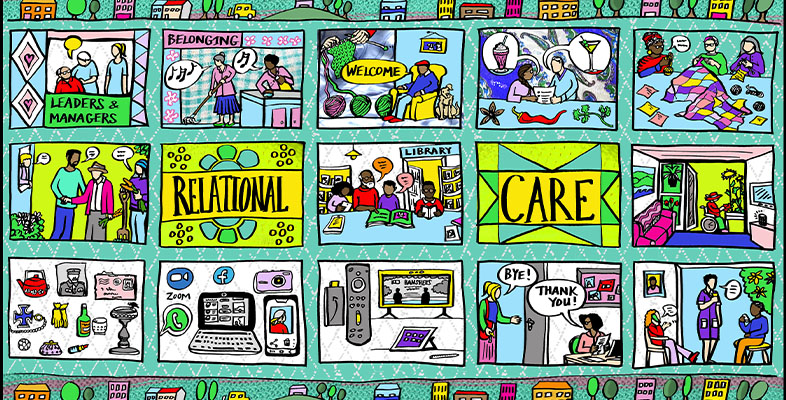2.2 Key components, principles and features of relational care practice
The three main requirements of relational care practice are:
- An atmosphere of respect, trust and inclusivity that nurtures belonging
- A purposeful focus on relationships
- A physical environment that facilitates relationships and autonomy.
Although not exhaustive, the model of relational care shown below in Table 1 sets out how these three requirements interact and are supported by specific activities, practices and features of the environment.
| An atmosphere of respect trust and inclusivity that nurtures belonging | A purposeful focus on relationships | A physical environment that facilitates relationships and autonomy |
|---|---|---|
Leaders and managers create a home-like environment in which all those in it can flourish and thrive. |
Between staff and residents, e.g.
|
Room layouts allow for private and communal space (inside and outside). |
Residents feel a sense of belonging and sufficiently ‘at home’ to enjoy freedom of expression and find meaning in their lives. |
Amongst residents, e.g.
|
Recognition and encouragement of meaningful objects and activities. |
Visitors experience the setting as welcoming and accommodating. |
Amongst staff (including staff and management), e.g.
|
Use of communication and other technologies to release staff time. |
Between the care setting, the family and the wider community, e.g.
|
Use of assistive technology to support autonomy and foster relationships such as mobility aids, gadgets and entertainment equipment. |
|
An ‘open door’ to the manager’s office. |
||
Private spaces for staff. |
You are probably wondering how this model translates into practice? The next activity involves looking at an example of the model in action.
Activity 5 Fairview House and relational care
This activity has two parts and involves you reading and/or listening to a case study about a care home called Fairview House, a fictional care home based on empirical research with care settings across the UK.
Part A
Read or listen to the the case study.

Transcript: Video 4 Fairview House case study
Fairview House
Fairview House is in an English market town on the Scottish borders and has around 40 residents, about half of whom are living with dementia. Originally a very large, old vicarage, it was converted to its current role in the 1970s and has since been fully repurposed and redecorated by a large care group in the voluntary sector, which bought it in the early 1990s.
It still has quite a quirky interior, with nooks and crannies rather than straight corridors, and a variety of accessible bedrooms for individual occupancy. Good natural light is evident all around, and the repurposing of the building – which included the addition of a conservatory – has brought much more light into the dining room. There is also a separate room for staff to relax in and have as their own ‘space’. The square entrance hall is furnished with sofas, which are similar in style to that which residents may have been used to before they moved in. It also has a large noticeboard with information about activities and requests for residents’ views.
To the right of the entrance hall a door stands open to the manager’s office. A resident comfortably settled on a small sofa, greets visitors with a welcoming smile. The manager, Jean, has worked here for over 30 years – having joined as a care attendant and been supported through a journey of formal and informal learning to reach her current post. The retention and longevity of Fairview's staff is something of which they are proud.
The home’s place in its community has played a role in this: it benefits from being able to recruit from nearby because it is known and respected. Additionally, staff may have friends or family already here. Some residents know the staff from previous lives too, having been their teachers, parents’ friends and so on. The philosophy is that ‘It’s important to include all the relationships that surround a resident’. Fairview House aims to be part of its locality in every sense, by opening its doors and large garden to people nearby who may enjoy the facilities.
Residents can also help to maintain the garden if they wish. Similarly, it’s easy for residents to go into the town for shopping, to see friends, or go to a place of worship. Some may need to be accompanied in which case the view is that this should be a shared pleasure for them and the carer who goes with them.
The two large lounges have been split into four distinctive areas, with chairs and coffee tables that are easy to move and arrange into different groups. The TV is contained in one area such that it does not dominate. Another of the areas has tea and coffee making facilities so residents can sit there with their guests. Whilst the whole arrangement encourages interaction, conversation and small group activities, the areas can be rearranged to create a more open space for music or watching the TV together for a special programme.
Just off one of the lounges is a small alcove where there is a collection of laptops and iPads for those residents who want to use them with or without the help of a member of the staff team. Another feature of Fairview House is its ‘personalisation’. Residents’ photos, pictures, and ornaments are part of the communal spaces and the décor, so everywhere reflects the ‘family’ that lives there. Like the sofas in the entrance hall, the décor and the furniture has been chosen to reflect residents’ tastes, rather than the bland luxury of a hotel. This is achieved in part by consulting all concerned when changes are made – residents and staff – and also by understanding the local culture.
The well-used garden, with carefully laid paths, various resting points and a covered gazebo for the summer, is accessed through a conservatory designed to ‘bring the outside in’. The conservatory is a warm, light, comfortable place giving views over the open country in which many of the residents would have been brought up and some would have farmed.
Marie, the activities champion, aims to get residents and staff alike involved in craft groups, music, talks, celebrations and outings. All the activities are planned together, as a community, so everyone can look forward to them. She helps steering groups of residents to put on celebrations for national and sporting events. Time is built into rotas to allow for some staff participation, and to give as much flexibility as possible to accommodate residents’ hobbies. In Marie’s words, an example of the latter is: “If there’s something they want to bake we would bring everything out into the dining room for them, if they were making a cake or something like that.” Similarly, residents are able to contribute to their care home community as they wish to and can, for instance by gardening, sorting the books and puzzles and so on.
Meals are an important part of the day, with lunch in particular bringing most people together. Those living with dementia are helped by the staff, and also by their fellow diners. The meal arrangements and variety of the rooms give a choice of environment, privacy, quiet or company. Access to objects of both emotional and practical significance is also very important to autonomy and to forming relationships. The staff at Fairview House are given the flexibility and time to recognise these individual needs.
As with all care homes, or community facilities, Fairview House has to deal with loss, and the inevitability that members of that ‘family’ will pass away. Staff are supported in bereavement, and family members are helped to be with their loved ones by rearranging rooms, adding a small bed, bringing in meals and providing solace if it is wanted. Staff are also enabled to go to funerals.
Now, using the table below, make a note of the various ways in which Fairview House is enabling and sustaining relational care.
| An atmosphere of respect, trust and inclusivity that nurtures belonging | A purposeful focus on relationships | A physical environment that facilitates relationships and autonomy |
|---|---|---|
Comment
A part-completed version of this table is set out below. Have a look at your own table and see if there are any other points you would like to add.
| An atmosphere of respect, trust and inclusivity that nurtures belonging | A purposeful focus on relationships | A physical environment that facilitates relationships and autonomy |
|---|---|---|
| Fairview House encourages residents’ views and the manager has an ‘open door’ policy so that everyone feels welcome and can come in with ideas or complaints. However, staff do have a private space as well. | Fairview House helps people maintain current relationships as well as create new ones, by making sure the local community feels welcome to visit and also enjoy the garden. | Staff are given flexibility and time to understand what surroundings and objects are important to people. Residents are also encouraged to share these special objects by having them in communal areas to make them part of everyone’s home. |
Part B
Thinking about your own work, what might be difficult or challenging about putting the three main requirements of relational care in place?
[Tip: Consider the list above that you have just written for Fairview House and note down one difficulty that might arise and add one suggestion to overcome the difficulty for each of the three items].
| An atmosphere of respect, trust and inclusivity that nurtures belonging | A purposeful focus on relationships | A physical environment that facilitates relationships and autonomy |
|---|---|---|
Comment
As in the first part of this activity, here is a part-completed version of Table 3. This should help further develop your thinking about the issues involved in putting the three main requirements of relational care in place and overcoming any challenges involved.
| An atmosphere of respect, trust and inclusivity that nurtures belonging | A purposeful focus on relationships | A physical environment that facilitates relationships and autonomy |
|---|---|---|
| This could be challenging if the manager needs to have private conversations and people feel excluded or anxious about what’s happening. This could probably be overcome if she sets aside a time for ‘closed door’ say, once a day, so it doesn’t arouse comment. | Most people would enjoy the open welcome Fairview House offers and not misuse it, but it would be important to make sure that people didn’t just wander in and disrupt mealtimes or activities. Staff could look out for anyone like this and have a quick welcoming chat, but also explain if it wasn’t a good time. | If residents wanted to have unsuitable objects in communal areas – for example, a very large and dominant painting that most people weren’t keen on, or something that was a trip hazard (such as a huge planter) – this would need to be discussed between manager and resident and a compromise reached, e.g. a different object or place. |
In this section you examined how relational care can be encouraged and sustained in your day-to-day practice. This first requires recognising and being aware of the different kinds of (inter)relationships within and beyond the care setting that make a difference to the wellbeing of those living and working there. Through a case study of a care home, you also explored the key components of relational care and how these can be operationalised in practice.
